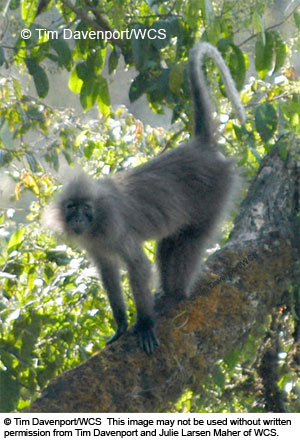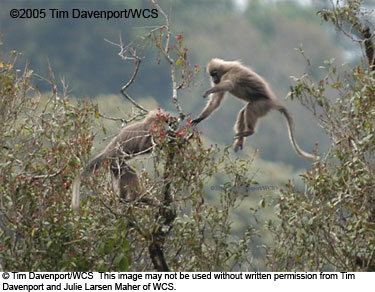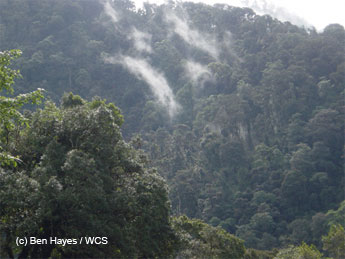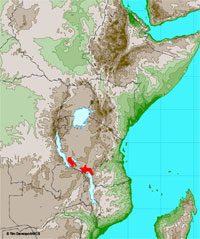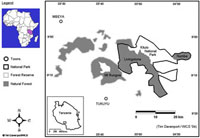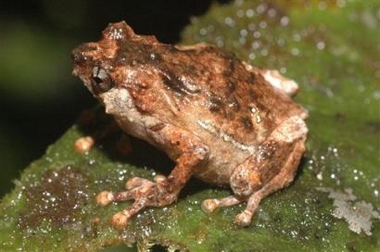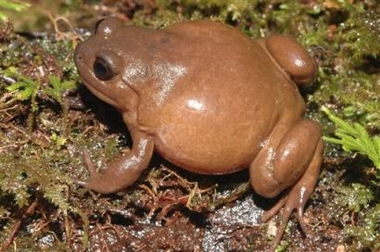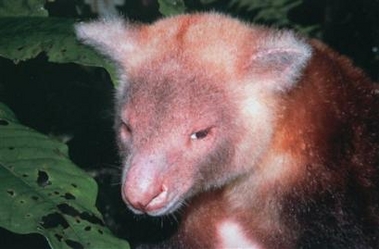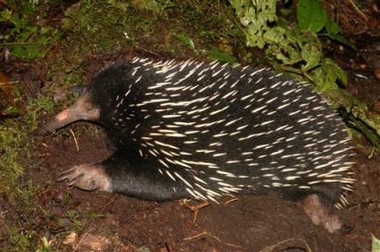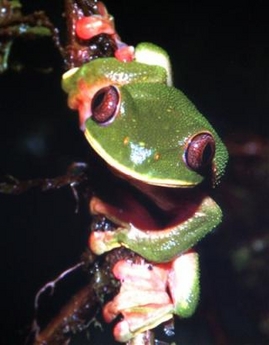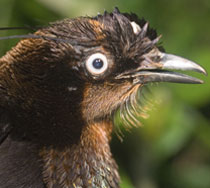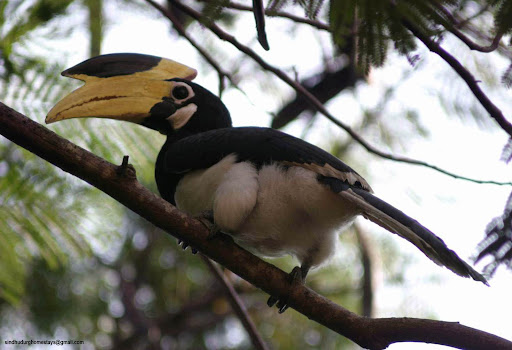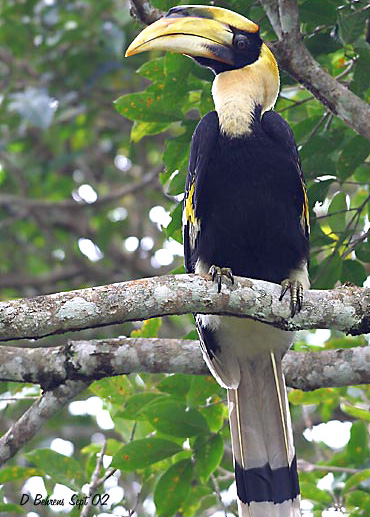
Lingkungan Hidup
Species Kucing Baru Ditemukan di Indonesia
Oleh : Wahyu Ari Wicaksono
22-Mar-2007, 14:14:26 WIB - [www.kabarindonesia.com]
Para ilmuwan di Swiss mempublikasikan bahwa macan dahan yang ditemukan di Borneo dan Sumatra adalah spesies baru. Binatang yang bersembunyi di hutan tropis ini sebelumnya dianggap spesies yang sama dengan macan dahan yang hidup di daratan utama Asia Tenggara.
Berita mengenai adanya temuan tersebut dipublikasikan beberapa minggu setelah dirilisnya laporan WWF yang mengabarkan bahwa para ilmuwan berhasil mengidentifikasikan tidak kurang dari 52 spesies satwa dan tumbuhan baru di Borneo dalam periode satu tahun saja. WWF meyakini dengan adanya temuan-temuan baru yang berulang kali seperti itu semakin jelas betapa pentingnya perlindungan habitat dan spesies dari pulau nomor tiga terbesar di dunia tersebut.
Para peneliti di Institut Nasional Kanker Amerika Serikat mengatakan perbedaan antara macan dahan yang ada di Kalimantan dengan yang ada di Asia Tenggara perbandingannya setara dengan perbedaan yang ada antar spesies kucing besar lainnya semacam singa, harimau, macan tutul dan macan kumbang. Mereka meyakini bahwa populasi di Borneo adalah deviasi dari populasi yang ada di daratan utama Asia sekitar 1,4 juta tahun yang lalu.
“Hasil penelitian genetik secara jelas menunjukkan bahwa macan dahan di Borneo harus dianggap sebagai spesies berbeda,” kata Dr Stephen O'Brien, Kepala Laboratorium Keragaman Genom, Institut Kanker Amerika Serikat. “Tes DNA menemukan kira-kira ada 40 perbedaan genetik antara kedua spesies tersebut.”
Hasil studi genetik ini juga didukung oleh riset lainnya yang menelaah pola dan corak warna kulit macan dahan yang disimpan di museum, yang dikoleksi dari berbagai lokasi geografis.
“Pada waktu kita mulai membandingkan kulit macan dahan di belahan Asia Tenggara dan yang ditemukan di Borneo, semakin jelas bahwa kita sedang membandingkan dua spesies yang berbeda,” Dr. Andrew Kitchener, dari Departmen Ilmu Pengetahuan Alam, Museum Nasional di Skotlandia.. “Cukup mencengangkan bahwa tidak seorangpun menyadari perbedaan-perbedaan tersebut.”
Macan dahan Borneo memiliki tanda ‘gelap’, beberapa ciri-ciri lain sekitar tanda gelap itu yaitu, bulu yang keabu-abuan, dan sirip loreng ganda. Semuanya lebih gelap daripada spesies yang ada di daratan utama Asia Tenggara. Kulit macan dahan Borneo biasanya mempunyai corak berawan yang lebih besar, lebih sedikit dan pucat, serta adanya tutul-tutul dengan kecenderungan bulu kecoklatan dan sebagian loreng ganda.
“Siapa bilang tanda-tanda pada macan tutul tidak dapat berubah? Sejak lebih dari seratus tahun kita terus mencari binatang ini dan tidak pernah membayangkan keunikannya,” kata Stuart Chapman, WWF International Coordinator untuk Heart of Borneo programme. “Kenyataannya, predator utama di hutan Borneo ini sekarang dinyatakan sebagai spesies berbeda sehingga semakin menguatkan pentingnya konservasi kawasan Jantung Borneo ini.”
Macan dahan adalah predator terbesar di Borneo, terkadang besarnya hampir sama dengan panther ukuran kecil, dan tercatat memiliki gigi taring terpanjang sebesar ukuran tubuh kucing. Rusaknya habitat di mana mereka hidup adalah ancaman utama. Habitat terakhir berupa hutan luas bagi macan dahan Borneo ini adalah Heart of Borneo, yaitu areal sekitar 220.000 km2, wilayah pegunungan - dengan luas sekitar lima kali ukuran Swiss - tertutup oleh hutan tropis khatulistiwa di tengah-tengah pulau.
Dengan mempertimbangkan kondisi hutan di Borneo, jumlah populasi macan dahan diperkirakan berkisar antara 5.000-11.000 ekor. Total jumlah yang ada di Sumatra sekitar 3.000-7.000 ekor. Kepala Pusat Penelitian Biologi Indonesia - LIPI, Dr. Dedy Darnaedi menambahkan, “Sekali pun begitu, diperlukan studi lebih lanjut untuk mendapatkan data populasi lebih baik dan perlu komunikasi lebih lanjut dengan Museum Nasional di Skotlandia untuk membandingkan laporan-laporan yang ada sekarang.”
Bulan lalu di Bali, para menteri dari tiga Negara- Brunei Darussalam, Indonesia dan Malaysia - menandatangani Deklarasi bersejarah untuk melindungi dan mengelola Jantung Borneo secara berkelanjutan. Hal ini menjadikan wilayah tersebut sebagai prioritas konservasi di panggung internasional.
Sumber foto: www.kompas.com



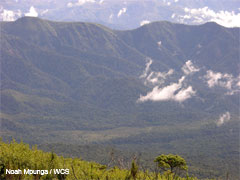 The Livingstone escarpment within Kitulo National Park viewed from the summit of Mt Rungwe. Photo: Noah Mpunga / WCS
The Livingstone escarpment within Kitulo National Park viewed from the summit of Mt Rungwe. Photo: Noah Mpunga / WCS 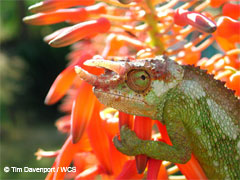 The Poroto Three-horned Chameleon (Chamaeleo fuelleborni) is one of the rarest chameleons on the continent, globally restricted to just four sites in Tanzania's Southern Highlands. Reaching a length of 22 cm, the males of this arboreal species are highly territorial, using their horns to fight for females. They give birth to as many as 15 live young (Photo (c) Tim Davenport / WCS)
The Poroto Three-horned Chameleon (Chamaeleo fuelleborni) is one of the rarest chameleons on the continent, globally restricted to just four sites in Tanzania's Southern Highlands. Reaching a length of 22 cm, the males of this arboreal species are highly territorial, using their horns to fight for females. They give birth to as many as 15 live young (Photo (c) Tim Davenport / WCS) 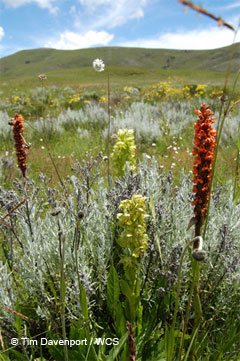 Bustani ya Mungu - God's garden. Satyrium and Habenaria orchids on Kitulo Plateau. Photo: Tim Davenport / WCS
Bustani ya Mungu - God's garden. Satyrium and Habenaria orchids on Kitulo Plateau. Photo: Tim Davenport / WCS